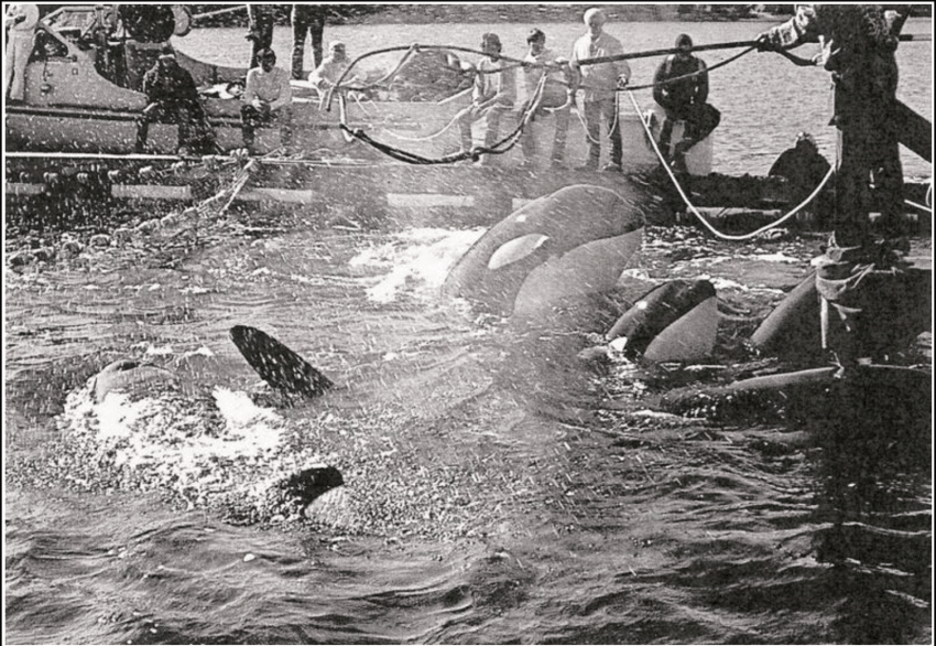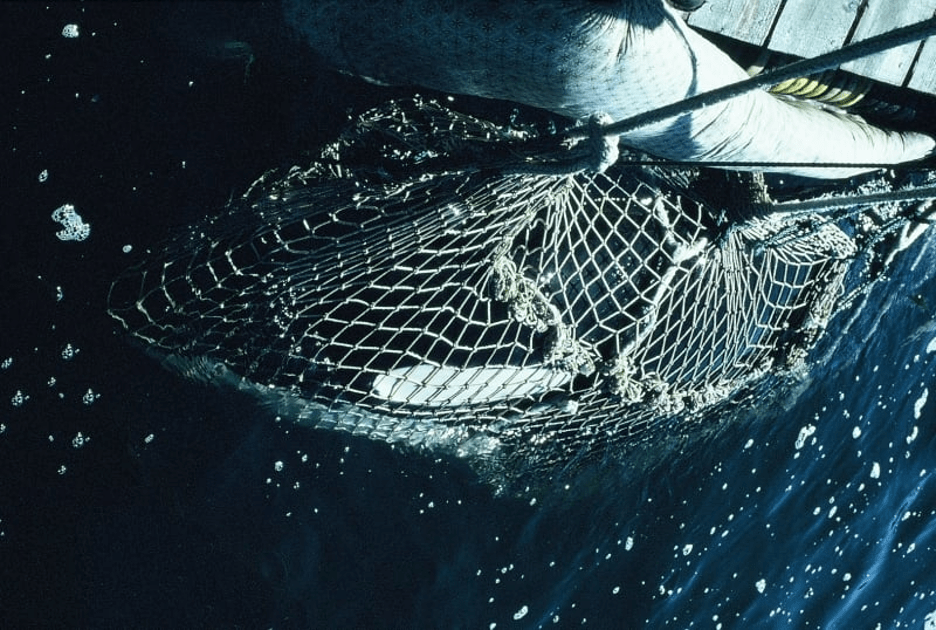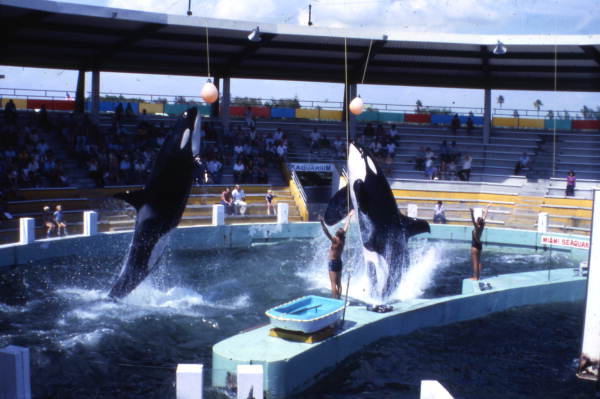
Lolita was the sole orca living in the Whale Bowl at Miami Seaquarium for over 40 years. Also known as Tokitae, Lolita passed away in August 2023 after more than 50 years of captivity.
Lolita, the orca who lived at the Miami Seaquarium, was born around 1966 in the Pacific Northwest as a member of the Southern Resident orca population. One of the saddest stories of a captive orca, Lolita was taken from the wild in August of 1970 and held at the Miami Seaquarium for more than half a century.
Believed to have been born to Ocean Sun, also known as L25, Lolita’s first few years of life were spent traveling between 75 and 100 miles each day with her pod, learning their calls and high-pitched clicks, and learning to catch her own fish by the end of her first year.
Around this time, the craze for capturing orcas for entertainment was starting to develop when an orca named Namu, a Northern Resident orca, became the first orca to be captured and kept in captivity. Ted Griffin, who owned the Seattle Marine Aquarium at the time, is widely known for being the inventor of orca captivity due to his capture of Namu and is the first person to have ever swum with a captive orca.

A 1970 orca capture in Puget Sound. Credit: ©Terrell C. Newby, Ph.D.
Namu, captured in 1965, was kept in a show pen on the Seattle waterfront, and people flocked to see the “tamed and trained” killer whale. In order to keep a companion for Namu, a Southern Resident orca adult was harpooned from a helicopter while swimming with her calf. The calf, after watching her mother die from harpoon wounds, was netted and hauled into the pen and given the name Shamu. Traumatized by the ordeal, Shamu reportedly didn’t get along with Namu and was eventually sent to SeaWorld San Diego.
A year after Shamu’s capture, the first large-scale orca capture took place in Puget Sound as business for orca entertainment was booming thanks in part to SeaWorld’s brand new Shamu Show. Similar to how dolphins and other species of whales are herded into the cove of Taiji to this day, this pod was herded into a cove into Puget Sound with speed boats and bombs such as M-80s and was surrounded by nets.
During the capture, three orcas drowned, and five juvenile orcas were taken from their home in the sea. In similar circumstances, a family of orcas was trapped off the coast of Washington in 1968. One of the two juveniles captured was three-year-old Hugo, who was sent to live at Miami Seaquarium and became the venue’s first orca.

Lolita during her capture in Puget Sound. Credit: ©Terrell C. Newby, Ph.D.
Hugo was the only orca at the Miami Seaquarium in the Celebrity Pool for two years. As Hugo spent his days in the Celebrity Pool, Lolita was one of seven young killer whales being captured by Ted Griffin and Don Goldsberry of Namu, Inc. On August 8, 1970, in Penn Cove, over 80 orcas were rounded up and five killer whales—including four baby orcas—died during this capture.
As recorded in the groundbreaking documentary Blackfish, which focused on Tilikum’s life and capture, the drowned orcas had their bellies slit, were filled with rocks, and were weighted with chains and anchors in order to keep their deaths from outraging the public. Unfortunately, this became routine in orca captures as the animals tried to escape and protect their young while getting caught in the nets and drowning.
Dr. Jesse White, veterinarian of Miami Seaquarium at the time, went to see the captured orcas in order to find a companion for Hugo. He chose one and called her Tokitae, named after a carving he found in a curio shop, but the Miami Seaquarium’s owners, in an effort to hide where she came from as public outrage of orca captures heightened, eventually called her Lolita to be “more Miami.” Spanish in origin, Lolita means “pains” or “sorrows,” something the orca endured for the rest of her life.
A month after this enormous orca roundup and capture, Lolita arrived at the Miami Seaquarium in Florida on September 24, 1970. Unbeknownst to Miami Seaquarium, which kept Lolita and Hugo in separate tanks for the first several weeks assuming the two orcas would fight, they both were Southern Resident orcas and would call to each other across the park grounds.
Eventually, Hugo and Lolita were kept in the Whale Bowl together, forced to perform in a tank that was barely deeper than their bodies were long. This tank was a mere 80 feet by 35 feet (24 meters by 11 meters) and only 20 feet (6 meters) deep and was dubbed the smallest orca tank in North America. Hugo’s head would regularly be out of the water as his tail was touching the concrete bottom. Similarly, Lolita’s body was about as long as the Whale Bowl was deep, so neither orca could dive deep and swim the way they would in the wild with their pod.
In the coming years, The USDA would eventually fail to enforce the Animal Welfare Act in regards to the size of Lolita’s tank, which requires a minimum horizontal dimension of at least 48 feet wide in both directions.
During their time performing together, Hugo would regularly attack his trainers by biting and bumping into them. He also self-harmed regularly, known to bash his head into the side of his tank and even once slicing off the tip of his rostrum, which had to be surgically reattached. Lolita, though less aggressive in comparison, would join in these trainer attacks, according to former trainer Manny Valesco.
On March 4, 1980, Hugo suffered a brain aneurysm, likely due to the repeated bashing of his head against the bars and walls in his tank. He died at just 15 years old, leaving Lolita alone in her tank after a decade of living with Hugo. She would never see another orca again. By 1987, Lolita was the only survivor of the approximately 58 orcas captured from Puget Sound.
In 1995, a campaign was launched by Howard Garrett from the Orca Network in an effort to return Lolita to her native waters after the 1993 hit movie Free Willy stirred public outcry for the release of Keiko, who starred as Willy in the film. Keiko, who lived in the ocean and enjoyed interactions with other animals and catching prey until his death in 2003, started reintegrating into the wild in 1996. Because of the success of Keiko’s reintegration, advocates believed Lolita had a chance at a similar rehabilitation.
Unfortunately, the CEO of the Miami Seaquarium at the time denied the requests of state officials to purchase Lolita in order to move her to an open sea pen.
Lolita would continue to perform in the Whale Bowl for decades, eventually having different species of dolphin placed in her tank. Mostly Pacific white-sided dolphins, including Elelo, Bimini, Catalina, and Li’i shared the tank with the 22-foot-long killer whale.
Both Lolita and the dolphins routinely attacked each other, and it’s believed a number of dolphins were killed by Lolita. Catalina, who died in December of 2021, was one of the dolphins assumed to have been killed due to an aggressive incident with Lolita.

Orcas leaping out of the water during a show at Miami Seaquarium. Credit: State Archives of Florida/Florida. - Division of Tourism
Eventually, the release of Blackfish, following the tragic death of Dawn Brancheau due to Tilikum’s attack, reignited passion in ending orca captivity worldwide, with a particular highlight on the killer whale living in the smallest orca tank in North America a mere 3.5 hour drive away from the Blackfish star.
Throughout the years, animal activists, including World Animal Protection US, would protest outside of Miami Seaquarium for its grotesque treatment of Lolita and other animals. For decades, thousands of dedicated animal rights activists would call for an end to orca captivity and seaside sanctuaries to be built where marine mammals could thrive in a more natural environment.
The Lummi Nation, the third-largest Native American tribe in Washington State, began its work to bring Lolita home in 2018, stating they had a sacred obligation to bring her back to the Salish Sea. The Lummi Nation renamed her Sk’aliCh’elh-tenaut, meaning “our relations below the waves,” and partnered with the Whale Sanctuary Project and Earth Law Center to create a legal and logistical plan so that Lolita could eventually feel the currents of the ocean and hear the calls of her pod members again.
Free Lolita.
— World Animal Protection US (@MoveTheWorldUS) August 8, 2020
Free Lolita.
Free Lolita.
Free Lolita.
Free Lolita.
Free Lolita.
Free Lolita.
Free Lolita.
Free Lolita.
Free Lolita.
Free Lolita.
Free Lolita.
Free Lolita.
Free Lolita.
Free Lolita.#FreeLolita
[video taken at 2018 #EmptyTheTanks Miami protest] pic.twitter.com/eo9vnnSFJX
In March of 2022, after one of many scathing USDA inspection reports found that Lolita was fed rotting fish and forced to perform dangerous tricks despite veterinary instructions to the contrary, Lolita’s performances came to an end when the USDA granted The Dolphin Company ownership of the Miami Seaquarium. In this license from the USDA, The Dolphin Company was not permitted to force Lolita or Li’i, a Pacific white-sided dolphin, to perform shows for entertainment.
One year later, the Miami Seaquarium announced that it would be returning Lolita to an ocean sanctuary in Washington State.
(It should be noted that since Lolita was not permitted to perform and was taken off display from the public, it’s likely she was costing the venue money as it could not profit from her. Therefore, it’s a fair assumption that this was more of a business decision rather than a moral decision in order to gain goodwill from the public and remove a costly animal from the venue.)
This announcement unfortunately would come too late for the orca, who died less than five months later on August 18, 2023. She was one of the oldest orcas held in captivity and the last captive Southern Resident orca, dying at approximately 57 years old.
According to the Miami Seaquarium and a necropsy performed by the University of Georgia, Lolita died from “progression of multiple chronic conditions including renal disease and pneumonia.” What the Miami Seaquarium failed to disclose immediately at the time her death was announced was that Lolita had undergone a medical procedure the morning of her death and was unable to stabilize afterwards. She died around 4 PM EST that afternoon.
Lindsay Oliver, World Animal Protection US’s Executive Director, told People at the time:
“Watching Tokitae wither away in captivity broke my heart. She deserved the freedom of the open sea, not a life confined to a small tank. It's time for this industry to end, so no more animals have to suffer like this. Swim free, Tokitae.”
Lolita’s former veterinarian of more than 20 years, Magdalena Rodriguez—who was not present during the procedure due to being fired for speaking out about the poor animal care conditions at the venue—noted at the time that medical examiners should be “highly suspicious” that the medical procedure contributed to Lolita’s death.
Orcas are conscious breathers unlike humans, meaning they must choose to surface and take each breath. Rodriguez suggests Lolita was likely losing consciousness during the procedure, impacting her breathing.
Just days before her death, the Miami Seaquarium stated that Lolita was doing well and that she was “stable,” making her former trainers, including Edward Akromas, question her rapid decline. Akromas also noted that at the time of her death, Lolita was eating only 115 pounds of fish a day, but required 150-200 pounds a day to meet her renal needs.
Former veterinarians and trainers of Lolita said she was inadequately cared for and fed during her captive life, directly contributing to her death. Dr. Jenna Wallace, who has been outspoken about the entertainment venue since Lolita died, told the Miami Herald:
“We’ve been saying for a long time they’re going to kill her at the Seaquarium. We’ve been fighting so hard to get her the best treatment and get her out of there, but nobody listened. It shouldn’t have ended like this. She deserved better.”
Had she lived, the plan for returning Lolita back to the Salish Sea would not have been in motion for years. The Dolphin Company reported at the time that Lolita would be transported sometime between October 2024 and April 2025, forcing her to live almost two more years in the smallest orca tank in the United States.
After her necropsy, Lolita’s body was cremated, her ashes being sent back to the Lummi Nation. The Native American tribe held a private ceremony and spread her ashes in the Salish Sea, returning the orca to her home as they promised.
Ted Griffin, the man who captured Lolita and sold her to the Miami Seaquarium for a mere $6,000, commented on her death, saying he has “no regrets” for what he forced Lolita—and hundreds of other orcas—to endure.
At the time of her death, Lolita shared the Whale Bowl with Li’i, who was eventually moved to SeaWorld San Antonio in September 2023, where the 40-year-old dolphin lives in tanks with other Pacific white-sided dolphins. In 2019, World Animal Protection US called out SeaWorld San Antonio, Li’i’s new home, for being one of a dozen worldwide venues utilizing demeaning and unnatural animal performances for profit.
Since Lolita’s death in August 2023, the Miami Seaquarium was served an eviction notice by the Miami-Dade County Mayor’s office due to poor animal welfare conditions cited by the USDA. The Dolphin Company has vowed to fight the eviction, which is now being determined by the courts.
A number of animals, including Sushi and Bud, sea lions, and Sundance, a bottlenose dolphin, have also died at Miami Seaquarium, while others continue to remain in harm’s way.
Drone footage, obtained anonymously by World Animal Protection US in April 2024, found that the conditions at the Miami Seaquarium have not improved despite USDA inspection violations and warnings from Miami-Dade County. The Whale Bowl that held Lolita throughout her sad life remains empty and will likely be demolished.
Fifty years in a tank. Attacked by dolphins. Hasn’t seen another orca since 1980.
— World Animal Protection US (@MoveTheWorldUS) August 8, 2020
Lolita lives in the smallest orca tank in North America @MiamiSeaquarium. Today marks 50 years since her ocean capture.
It’s time to #FreeLolita & send her to a seaside sanctuary. #EmptyTheTanks pic.twitter.com/hJ6ktOcEES
Ocean Sun, or L25, is estimated to be over 95 years old and the oldest Southern Resident orca living today. Thought to have been born in 1928, scientists believe that she’s Lolita’s mother based on the analysis of the calls Lolita has made in her tank. Unfortunately, Ocean Sun will never have the chance to be reunited with her daughter again in this lifetime.
World Animal Protection urges everyone who loves orcas and was moved by Lolita’s story to never visit amusement parks where wild animals are kept captive and forced to perform for entertainment.
Protect marine animals further by supporting the SWIMS Act, which would phase out the exploitation of orcas, beluga whales, pilot whales, and false killer whales by making it illegal to capture and breed these animals for public display.